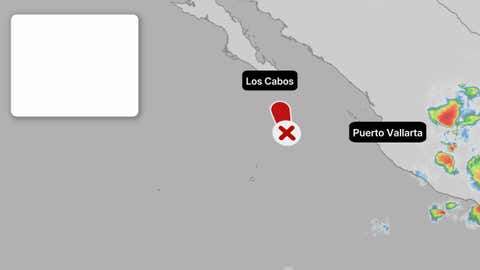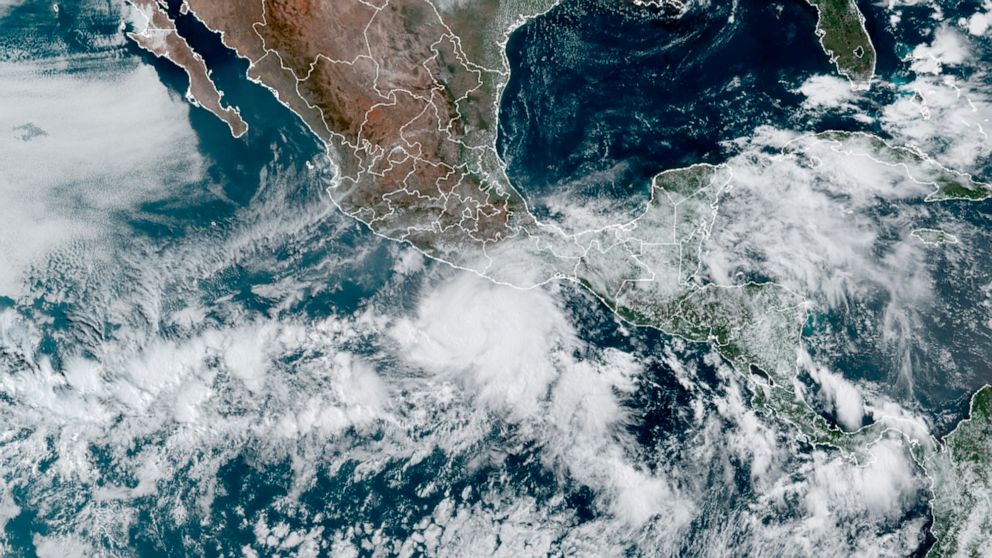[ad_1]

- The Eastern Pacific’s first storm of 2022 is pushing towards Mexico’s Pacific coast.
- It will arrive at the coast by late Monday as a hurricane.
- There is a chance its remnant could spawn another system in the Gulf or western Caribbean later this week.
- But there will be significant barriers that could hamper that development.
- Regardless, life-threatening rainfall flooding and mudslides are possible in Mexico and C. America.
Hurricane Agatha will threaten Mexico’s Pacific coast Monday, and a serious threat of flooding could linger in parts of Central America well into this week.
As of 4 a.m. CDT Sunday morning, the NHC upgraded the swirl of showers and thunderstorms a couple hundred miles off the southern coast of Mexico to Hurricane Agatha, the first of the east Pacific Hurricane Season.
Agatha underwent rapid intensification Sunday, when maximum sustained winds jumped 35 mph in under 24 hours. It will likely intensify further before landfall anywhere in Chiapas or Oaxaca states.
A hurricane warning is in effect for the southern coast of Mexico from Salina Cruz to Lagunas de Chacahua, where hurricane conditions are possible on Monday. Here’s a look at the current watches and warnings.

This system is expected to move slowly northeastward toward the Mexican Pacific coast by Monday, then embed itself in southern Mexico.

Current Storm Status and Forecast Path
(The red-shaded area denotes the potential path of the center of the tropical cyclone. It’s important to note that impacts (particularly heavy rain, high surf, coastal flooding, winds) with any tropical cyclone usually spread beyond its forecast path.)
Dangerous storm surge flooding and damaging winds are most possible within areas covered by warnings or watches.
Residents and those with vacation plans in those areas, including Acapulco, should monitor the forecast closely for important updates.
Flash Flood, Mudslide Danger
The system’s slow movement means dangerous flash flooding and mudslides are possible in parts of southern Mexico along and east of its path.
But even if Agatha dissipates over land, that’s not necessarily the end of the story.
Agatha’s circulation will pull Pacific moisture across Mexico and Central America for several days this week, where some locations may pick up over 6 inches of rain. Some communities may see up to 20 inches of rain, particularly in Mexico’s Oaxaca state. Portions of Chiapas and Guerrero could also see more than a foot of rain.

Rainfall Potential Next 7 Days
(This should be interpreted as a broad outlook of where the heaviest rain may fall and may shift based on the forecast path of the tropical cyclone. Higher amounts may occur where bands of rain stall over a period of a few hours. )
Could Eastern Pacific Remnant Spawn a Gulf Storm?
Agatha’s remnants or its broader circulation may reach the Bay of Campeche by the middle of the week where redevelopment is possible.
The National Hurricane Center says this chance is currently low.
But there is some recent precedence of such a Pacific to Atlantic basin crossover.
Near the end of May 2020, Tropical Storm Amanda formed in the Eastern Pacific Ocean, then moved inland and dissipated over the mountains of Guatemala.
But Amanda’s remnant spin above the ground – its “ghost,” if you will – continued moving north and northwest into the Bay of Campeche, the bowl-shaped bay at the southwestern end of the Gulf of Mexico.
Soon after the “ghost” emerged back over water, thunderstorms became more organized and surface low pressure reformed. What would soon become Tropical Storm Cristobal was born.
Incidentally, the combination of Amanda, Cristobal and a CAG over nine days dumped up to 34 inches of rain in southeast Mexico, 42 inches in El Salvador and 26 inches in Guatemala. Forty-three deaths were attributed to the flooding or landslides in Central America.

Track history of Tropical Storm Amanda, then Tropical Storm Cristobal in late May and early June 2020. The black portion of the track indicates where the remnant from Amanda tracked before spawning what would become Cristobal.
(Data: NOAA/NHC)
This “ghost” scenario is what some computer forecast models are suggesting could occur later this week.
Namely, Agatha may dissipate over southern Mexico, but remnant spin from Agatha above the ground could migrate into the Bay of Campeche late this week.
Another possibility is for development to occur over the western Caribbean Sea later this week.
It’s too early to determine which of these scenarios may occur.
But there’s one obstacle a Gulf or western Caribbean system seems likely to face.
The same forecast models suggesting development is possible are also forecasting strong wind shear over the Gulf and the Caribbean Sea this week.
This changing wind speed and/or direction with height tends to tilt or rip apart systems trying to consolidate thunderstorms and become tropical depressions or storms. It’s typically strong in these areas in early June.
Even if a tropical depression were to form in the Bay of Campeche later next week, it could be sheared apart if it tries to move northward in the Gulf of Mexico, if this wind shear forecast holds true.
Or, it could hold together, but be a lopsided depression or tropical storm limited in its intensity by wind shear.

Current Satellite and Wind Shear Analysis
(Areas of clouds are shown in white. Areas of strong wind shear, the difference in wind speed and direction with height, are shown in purple. High wind shear is hostile to mature tropical cyclones and those trying to develop.)
The western Gulf, Bay of Campeche and western Caribbean Sea have historically been hot spots for development in June.
Last year, Tropical Storm Claudette formed, then quickly moved ashore in Louisiana and the Deep South on Father’s Day weekend.

Origin points of all tropical/subtropical storms in the Atlantic Basin in June from 1950-2021.
(Data: NOAA)
The Upshot
The bottom line is the Eastern Pacific storm poses a danger of flooding rain and mudslides in southern Mexico and parts of Central America into the week ahead. Damaging winds and storm surge flooding can be expected near the coast close to where Agatha tracks.
For now, there’s no threat to the U.S. Gulf Coast, but that could change. Check back with weather.com for updates in the coming days.
It’s another reminder that now is a good time to develop or refresh your hurricane plan well before the season’s first storm or hurricane.
The Weather Company’s primary journalistic mission is to report on breaking weather news, the environment and the importance of science to our lives. This story does not necessarily represent the position of our parent company, IBM.
[ad_2]
Source link













